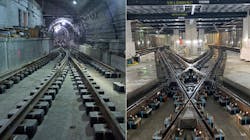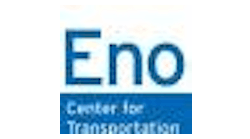A new Eno report examines how the U.S. can build better transit projects faster
Eno Center for Transportation has published a report looking at the current and historical trends of public transit construction, cost and delivery.
“If we are going to make a dent on climate, if we are going to deal with traffic congestion, if we are going to make sure people have access to jobs and opportunity, we are going to need more and better transit. And we’re not going to get more if we can’t figure out how to do them in a timely and cost-effective way,” said Eno President and CEO Robert Puentes.
Eno put together a database of 180 U.S. and international public transit projects completed since 2000 that includes information such as construction time, the scope of the project, percent tunneled, percent at grade, cost per kilometer, cost per mile and many other elements.
The database shows the three projects with the highest cost per mile in the U.S. to be two Metropolitan Transportation Authority projects, the 7 Extension, which opened in September 2015 with a cost per mile of US$3.034 billion and Phase 1 of the Second Avenue Subway, which opened Jan. 1, 2017, with a cost per mile of US$3.548 billion and San Francisco Municipal Transportation Agency Central Subway project, which is scheduled to open in 2022 with a cost per mile of $1.007 billion.
In comparison, the three highest cost per mile projects internationally were GVB’s North-South Line in Amsterdam that opened in July 2018 and had a cost per mile of US$766 and two Transport for London projects including the Jubilee Line Extension, which opened in December 1999 with a US$992 million cost per mile and the Battersea project which is scheduled to open this fall with a cost per mile of US$898 million.
Eno’s report found:
- On a per-mile basis, the U.S. pays a premium of nearly 50 percent for both primarily at-grade and primarily tunneled projects.
- When New York is lumped into the tunneling premium, it increased 250 percent.
- Slightly less than 12 percent of U.S. rail transit projects in the database were constructed primarily below ground versus 37 percent of non-U.S. projects.
- Costs for many international projects are similar whether they are below- or at-grade.
- International projects have more stations, run through city centers and are considered more complex versus U.S. projects, which typically run through dense historic city centers or are constructed on “paths of least resistance,” such as existing railroad right-of-way.
- It takes the U.S. longer to build projects: U.S. projects with minimal tunneling take approximately six months longer to build versus similar international projects and primarily below-grade projects take nearly 18 months longer to build.
Eno provided three policy and practice recommendations to break the cycle. These include:
- Getting the institutions, oversight and decision-making right: This means securing support from local jurisdictions, as well as the ability to acquire land and secure permits, among other steps. Additionally, construction contracts should be in manageable sections and project sponsors should better manage their relationships with private construction firms.
- Fixing slow, cumbersome and outdated processes, procedures and practices: The report recommends the federal government pilot a program to test if exempting transit project from certain environmental and community impact decisions makes sense. Needs in this area include better coordination among disparate federal agencies and outreach, training and capacity building for local agencies and project sponsors.
- Developing a new framework for how standards are applied to transit and the policy environment: Eno says the “over-customization of transit projects should be deemphasized in favor of standardization to save on construction costs and speed up delivery.” The report also recommends considering cost, complexity and ridership when designing projects; noting “cheaper does not mean it is better.”
In its conclusion, the report says, “Our thorough review of project delivery reveals that inadequate governance, cumbersome processes and outdated standards cost U.S. transit projects dearly. While there is no single cause for high costs and long timelines, the compounding effects of these underlying issues creates an environment of inefficiency that results in fewer projects being built, shorter transit lines and sub-optimal routing decisions that leave many systems underutilized. Implementing the changes necessary to tackle this problem will require a concerted effort at the federal, state and local levels.”
Eno’s report, “Saving Time and Making Cents: A Blueprint for Building Transit Better,” is available here.
The full database is linked here; U.S. transit projects appear in red while international projects appear in black.

Mischa Wanek-Libman | Group Editorial Director
Mischa Wanek-Libman is director of communications with Transdev North America. She has more than 20 years of experience working in the transportation industry covering construction projects, engineering challenges, transit and rail operations and best practices.
Wanek-Libman has held top editorial positions at freight rail and public transportation business-to-business publications including as editor-in-chief and editorial director of Mass Transit from 2018-2024. She has been recognized for editorial excellence through her individual work, as well as for collaborative content.
She is an active member of the American Public Transportation Association's Marketing and Communications Committee and served 14 years as a Board Observer on the National Railroad Construction and Maintenance Association (NRC) Board of Directors.
She is a graduate of Drake University in Des Moines, Iowa, where she earned a Bachelor of Arts degree in Journalism and Mass Communication.



